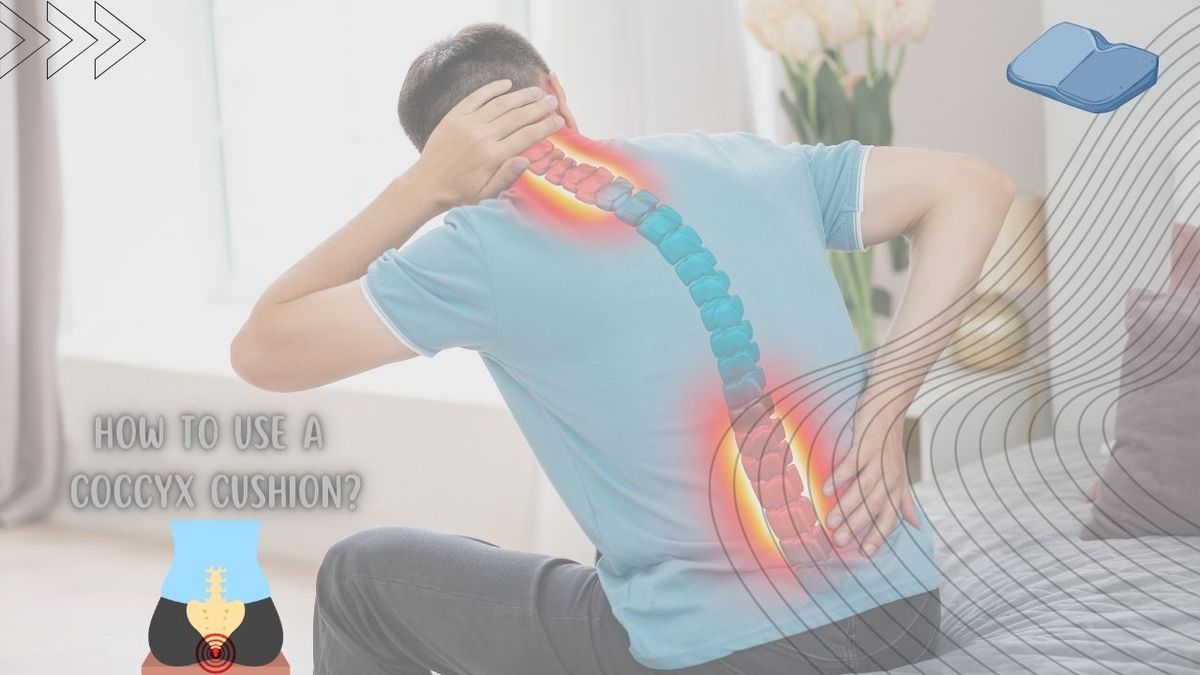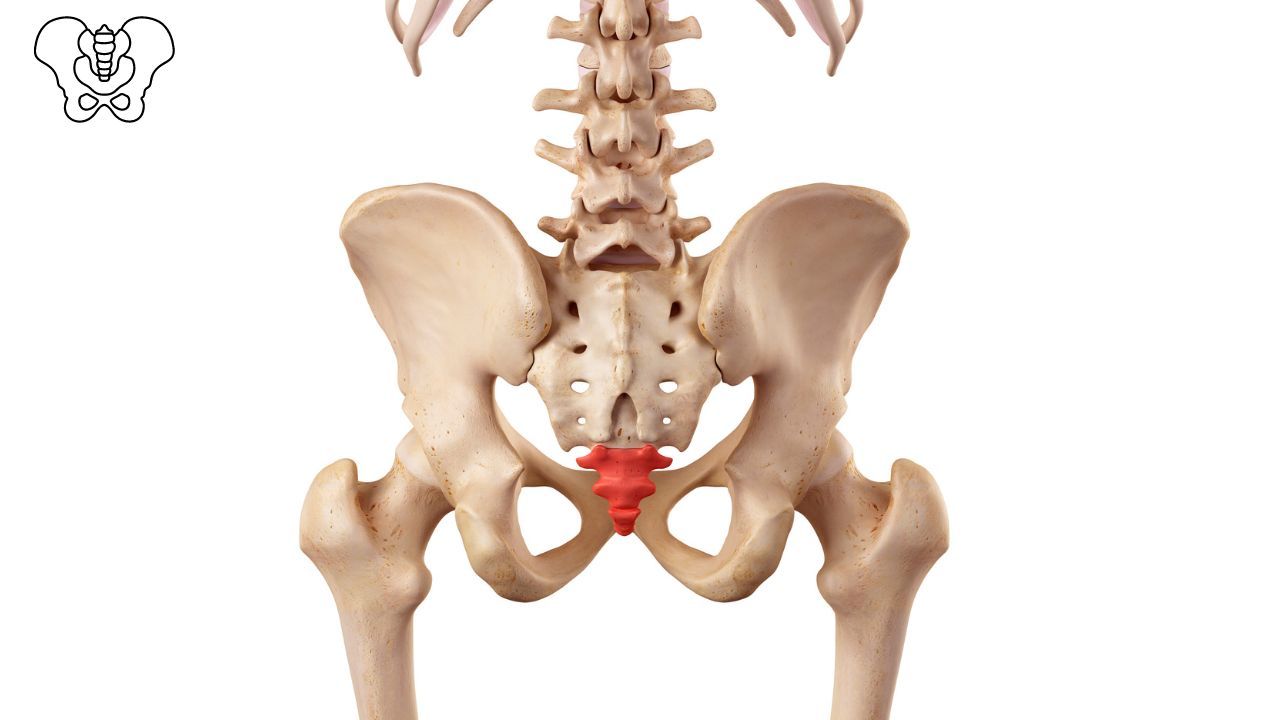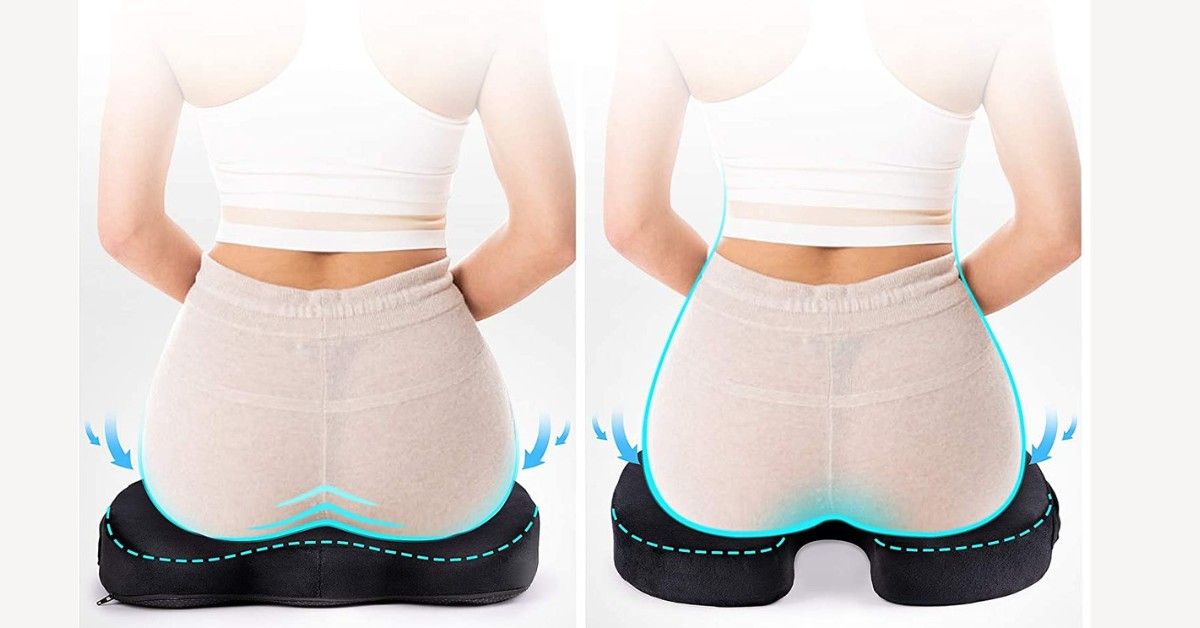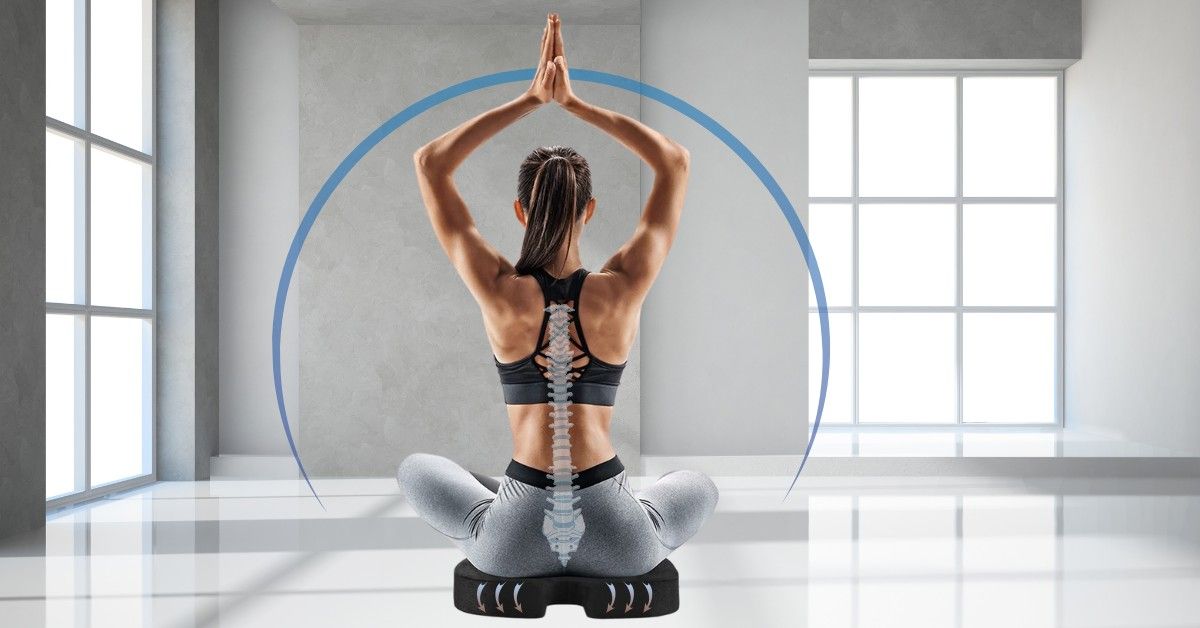How to Use a Coccyx Cushion?
Discover the art of pain-free sitting with our expert tips on effectively using a coccyx cushion – your key to unlocking unparalleled comfort and supporting your spine.

You're settling into your favorite chair after a long day, ready to binge-watch your latest TV obsession. But wait, there it is again – that pesky discomfort in your tailbone, throwing a "sit-down strike" just when you want to unwind.
In this article, we'll dive into the nitty-gritty of how to use a coccyx cushion to transform your sitting experience from "ouch" to "ahh!" Get ready for some tail-wagging comfort, and let's discover the art of coccyx cushion mastery together!
How do you get the most out of your coccyx cushion for ultimate comfort? We've got the scoop – keep reading to become a coccyx cushion connoisseur!
So, why keep those eager eyes scrolling? From mastering the perfect cushion placement to becoming a coccyx cushion pro, we've got a treasure trove of tips and tricks waiting for you. Ready to take the plunge into the world of coccyx cushion coziness? Let's dive in!
What Is Coccyx?
The coccyx, commonly referred to as the tailbone, is a small, triangular bone located at the base of the spine in humans. It consists of 3 to 5 fused vertebrae and serves as an attachment point for various muscles, tendons, and ligaments. While the coccyx has limited mobility and may not play a significant role in movement, it is essential for providing support and stability to the pelvic region.
The term "coccyx" is derived from the Greek word "kokkyx," meaning "cuckoo," due to its resemblance to the beak of a cuckoo bird. Despite its seemingly simple structure, the coccyx plays a crucial role in maintaining proper posture, stability, and weight distribution while sitting or standing.

Issues related to the coccyx, such as injury or discomfort, can lead to pain in the tailbone region. Conditions like coccydynia, which is characterized by coccyx pain, may arise due to trauma, prolonged sitting, or other factors. To alleviate coccyx-related discomfort, individuals often use specialized cushions, make ergonomic adjustments, or seek medical advice for proper management. 🦴
How to Use a Coccyx Cushion?
Whether it's an office chair, car seat, or your favorite reading nook, pick your throne for coccyx comfort.
Positioning Magic: Place the coccyx cushion on the seat with the cut-out or contour at the back, ensuring the tailbone area aligns with the opening.

Take a Seat: Sit down gently, allowing your tailbone to nestle into the cushion's groove. Feel that instant relief? That's the cushion's magic at work!

Adjust If Needed: Wiggle a bit and shift your weight to find the most comfortable spot. The cushion should support your tailbone without causing any pressure points.
Sit Back and Relax: Enjoy the sensation of sitting on a cloud of support. Maintain a natural spine alignment and avoid slouching – your back will thank you!
Remember, the coccyx cushion is your ticket to a happier sitting experience, so let it work its magic and bid farewell to tailbone woes. From workdays to movie nights, your coccyx cushion is your ultimate sitting sidekick. Enjoy the newfound comfort – you deserve it!
Why Coccyx Cushion?
The role of a coccyx cushion, also known as a tailbone cushion or orthopedic seat cushion, goes beyond providing mere comfort – it's a game-changer for your sitting experience.
- Tailbone Pain Relief: The coccyx cushion's primary role is to alleviate tailbone pain and discomfort. Its ergonomic design, often featuring a cut-out or contour at the back, relieves pressure on the sensitive tailbone area, making sitting more pleasant, especially for those with tailbone injuries or pain.
- Posture Enhancement: By promoting proper spinal alignment, the coccyx cushion helps improve posture. It prevents slouching, encourages a natural curvature of the spine, and reduces the risk of developing backaches due to poor posture.
- Pressure Distribution: The cushion's supportive materials evenly distribute your body weight, reducing pressure on the tailbone and lower back. This is especially crucial during long periods of sitting, helping to prevent discomfort and pressure sores.
- Comfort Amplification: Expect an upgrade in comfort like never before. The cushion's high-density foam or gel-infused materials provide a cushioned haven, making extended sitting more enjoyable.
- Reduce Pain: By reducing pain and discomfort, the coccyx cushion enhances your overall well-being.
- Post-Surgery Support: For individuals recovering from coccyx-related surgeries or procedures, the coccyx cushion offers a gentle and supportive surface to sit on during the healing process.
- Preventive Measure: Even if you're not experiencing tailbone pain now, using a coccyx cushion as a preventive measure can help maintain a healthy spine, prevent future discomfort, and promote good posture.
From soothing discomfort to promoting better posture, the coccyx cushion plays a vital role in your daily routine, supporting you in various settings and activities. So, go ahead and let this cushion be your silent, tailbone-loving hero as you sit your way to comfort and better posture.
How to Make the Best Use of Coccyx Seat Cushion
Maximizing the benefits of your coccyx seat cushion involves more than just placing it on your chair. Here's a guide to making the best use of your coccyx seat cushion for ultimate comfort and support:
- Proper Placement: Position the coccyx cut-out or contour at the back of the cushion directly under your tailbone. This targeted placement relieves pressure on the tailbone while maintaining natural spinal alignment.
- Find the Right Chair: Use your coccyx cushion on chairs with a flat, firm surface. Avoid overly cushioned seats that may compromise the cushion's effectiveness.
- Sit Gradually: As you sit down, gently lower yourself onto the cushion, allowing your tailbone to settle comfortably into the cut-out. Avoid plopping down abruptly.
- Shift and Adjust: Wiggle a bit and shift your weight to find the most comfortable position. This ensures the cushion's support is optimized for your unique anatomy.
- Maintain Good Posture: While the cushion provides tailbone relief, remember to maintain proper posture. Sit back in the chair, keeping your back straight and shoulders relaxed.
- Regular Breaks: Although the cushion offers comfort, it's important to stand up and stretch periodically, especially during long periods of sitting.
- Travel Companion: Take your coccyx cushion with you wherever you go. Use it in the car, on flights, and during events to ensure consistent comfort.
- Maintain Cleanliness: If your cushion comes with a removable cover, follow the manufacturer's cleaning instructions to keep it fresh and hygienic.
- Pair with Other Supports: Depending on your needs, you can use the coccyx cushion in combination with lumbar pillows or back supports to create a comprehensive seating solution.
- Consult Healthcare Professionals: If you have specific medical concerns or chronic pain, consult with a healthcare professional to ensure that a coccyx cushion is suitable for your condition.
- Be Patient: It might take a few days for your body to adjust to the cushion's support. Give yourself time to adapt and feel the benefits.
- Educate Others: If you notice friends or family members struggling with discomfort while sitting, share your coccyx cushion wisdom and help them discover the joys of tailbone relief.
Remember, a coccyx cushion is your ally in comfort, providing targeted support that can transform your sitting experience. By using it mindfully and in combination with good posture practices, you're well on your way to enjoying pain-free, comfortable sitting throughout your day.
How to Use a Coccyx Cushion?
FAQs
Q: Which way do you use a coccyx cushion?
Q: Do coccyx cushions work?
Answer: Yes, coccyx cushions are designed with specific features to provide relief and support, making them effective for many individuals. As mentioned above it helps relieve pain, reduce pressure on your spine, and promote good posture.
Q: How should I sit with coccyx pain?
Answer: When dealing with coccyx pain, sitting can become quite uncomfortable. However, making a few adjustments to your sitting posture and using a coccyx cushion can help alleviate discomfort. Here's how to sit with coccyx pain:
- Use a Coccyx Cushion: Place a coccyx cushion on your seat, positioning the cut-out or contour at the back to relieve pressure on your tailbone.
- Choose the Right Chair: Opt for chairs with firm and flat surfaces rather than soft or cushioned seats, as they provide better support and alignment.
- Lean Forward Slightly: When sitting, lean forward slightly from your hips while keeping your back straight. This can reduce pressure on the tailbone.
- Cross Your Legs: Sitting with your legs crossed can help distribute weight more evenly and reduce pressure on the tailbone.
- Sit on the Edge: Perch yourself on the edge of the chair, distributing your weight more towards your thighs and reducing direct pressure on the tailbone.
- Shift Your Weight: Periodically shift your weight from side to side or gently rock back and forth to prevent prolonged pressure on the tailbone.
- Use Armrests: If available, use armrests to help shift some weight off your tailbone.
- Stand and Stretch: Take breaks from sitting by standing up and gently stretching your back and legs. This can help relieve pressure and reduce discomfort.
- Maintain Good Posture: Keep your back straight, shoulders relaxed, and feet flat on the floor. Good posture can help reduce strain on your tailbone and lower back.
- Elevate Your Feet: If possible, use a footrest to elevate your feet slightly. This can help shift your weight and reduce pressure on your tailbone.
- Avoid Prolonged Sitting: Try to limit the amount of time you spend sitting. Stand up, walk around, and change positions regularly.
- Consult a Healthcare Professional: If your coccyx pain persists or worsens, consider seeking advice from a healthcare professional. They can provide personalized recommendations and treatment options.
Remember that finding the most comfortable sitting position may take some trial and error. It's essential to listen to your body and make adjustments that help alleviate your coccyx pain. If using a coccyx cushion and adjusting your sitting posture doesn't provide sufficient relief, consulting a healthcare provider is recommended.
Q: What position puts the most pressure on the coccyx?
Answer: Sitting in a slouched or rounded posture puts the most pressure on the coccyx. When you slouch, the tailbone may experience direct pressure and compression, which can exacerbate coccyx pain.
This occurs because the coccyx is positioned at the base of your spine, and when you slouch, your pelvis tilts backward, pushing your tailbone into the seat or surface you're sitting on.
Other positions that can increase pressure on the coccyx include:
- Sitting on Hard Surfaces: Sitting on hard, unforgiving surfaces without proper cushioning can lead to direct pressure on the coccyx.
- Sitting on the Floor: Sitting directly on the floor, especially on a hard surface, can place significant pressure on the tailbone.
- Cross-Legged Sitting: While crossing your legs can help distribute weight more evenly, sitting cross-legged for extended periods can still increase pressure on the coccyx.
- Leaning Backward: Leaning back in a chair with your weight resting on your tailbone can also intensify pressure and discomfort.
- Long Car Rides: Sitting for long periods during car rides, especially if your car seat lacks proper support, can lead to increased coccyx pressure.
To minimize pressure on the coccyx and reduce discomfort, it's important to maintain a good sitting posture, use supportive seating surfaces, and consider using a coccyx cushion. Additionally, taking breaks to stand, stretch, and shift positions can help alleviate coccyx pressure during prolonged sitting. If you're experiencing persistent coccyx pain, consult a healthcare professional for personalized guidance.
Q: Can you sleep with a coccyx cushion?
Answer: While coccyx cushions are primarily designed for sitting, they are generally not recommended for sleeping. Sleeping positions involve lying down, and using a coccyx cushion in bed may not provide the same level of support or comfort as it does during sitting. Additionally, using a coccyx cushion while sleeping could potentially lead to discomfort or interfere with your natural sleep posture.
If you experience coccyx pain while sleeping, here are some alternative strategies that you can consider:
- Pillow Support: Place a regular pillow or a specially designed pillow to support the lower back and pelvis under your hips while sleeping on your back. This can help alleviate pressure on the coccyx.
- Side Sleeping: If you prefer sleeping on your side, place a pillow between your knees to maintain proper spinal alignment and reduce pressure on the tailbone.
- Mattress Quality: Invest in a mattress that provides adequate support and comfort. A mattress that contours your body shape and promotes spinal alignment can contribute to reduced coccyx discomfort.
- Consult a Professional: If coccyx pain is significantly impacting your sleep, consult a healthcare professional. They can provide personalized advice and recommend strategies or treatments to improve your sleep quality.
Remember that individual comfort varies, and what works best for one person may not be suitable for another. It's important to prioritize proper sleep posture and seek guidance from a healthcare professional to address any persistent coccyx pain that affects your sleep.
Key Takeaways!
Incorporating a coccyx cushion into your daily routine can truly make a remarkable difference in your comfort and well-being. By following the simple yet effective guidelines on how to use a coccyx cushion, you're taking a proactive step toward alleviating discomfort, supporting your spine, and enjoying pain-free sitting. Remember, whether you're at work, in the car, or relaxing at home, your coccyx cushion can be your trusted companion for a more comfortable and enjoyable sitting experience. So go ahead, embrace the cushion's support, make those posture adjustments, and let comfort be your constant companion. Your tailbone will thank you for the extra care and attention.
Explore More About Coccyx Cushions!
- Ideas That'll Upgrade Your Home Office Comfort
- Cushioned Bliss: Unveiling the Best Travel Seat Cushion for Comfort & Adventure
- Unhappy With Your Office Chair, Simple Hack To Make Sitting Comfortable
- Fly in Comfort: The Airborne Oasis Guide to Finding the Best Airline Seat Cushion
- Office Essentials To Obsess Over And Forget Pain At Work
Our Featured Partner

